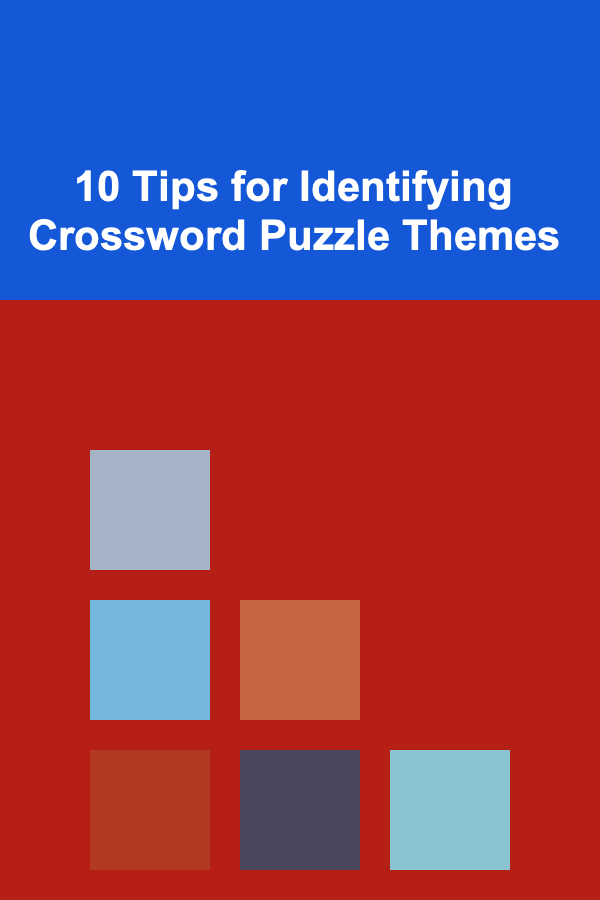
10 Tips for Identifying Crossword Puzzle Themes
ebook include PDF & Audio bundle (Micro Guide)
$12.99$6.99
Limited Time Offer! Order within the next:

Crossword puzzles are more than just a fun pastime---they're a blend of strategy, wordplay, and intellect. The most challenging and interesting crossword puzzles, especially those found in newspapers or competition settings, often include a theme. This theme ties together several clues or answers, giving the puzzle a unique flavor and an extra layer of complexity. For crossword enthusiasts, identifying the theme early on can make solving the puzzle more efficient and enjoyable. But how exactly can you identify a crossword puzzle's theme?
In this article, we will explore 10 tips for identifying crossword puzzle themes. Whether you're a novice solver or an experienced enthusiast, these strategies can help you tackle themed puzzles with greater ease.
Look for Unusual Answers
One of the first signs that a crossword puzzle has a theme is the presence of unusual or unusual-length answers. These answers often stand out because they are longer or less common than typical crossword answers.
- Unusual Word Lengths: If you notice that several of the longer answers fit together in a way that isn't typical for the grid, there's a chance they are thematically related.
- Thematic Answers: For example, you might find answers like "PIZZA DELIVERY," "TROPICAL FRUIT," or "GREAT ESCAPE." These answers often share a connection to the puzzle's theme.
In these cases, take note of the context in which the unusual answers appear in the puzzle. Often, they will follow a certain pattern or association that points to the puzzle's theme.
Check for Repeated Words or Phrases
Another effective way to identify a theme is by spotting repeated words or phrases within the grid. Many themed crosswords will feature words or phrases that repeat across the answers.
- Examples of Repeated Elements: If several answers in the grid include the word "dog," "star," or "moon," this could be a sign that the puzzle has an astronomy theme, or perhaps one focused on popular sayings involving those words.
- Phrase Repetition: Sometimes, a phrase itself could be repeated in the puzzle, like a famous saying or title (e.g., "ON THE ROAD," "IN THE DARK," "STORMY WEATHER"). This repeated pattern may point directly to a specific theme.
Look for these repeating elements, and ask yourself if they might relate to a broader category or topic.
Look for Puns or Wordplay
Crossword puzzle constructors often use puns or wordplay as a clue to the theme. If the puzzle has a clever twist, it could be part of the theme.
- Homophones and Wordplay: A theme might revolve around puns that involve homophones or double meanings. For example, answers like "PIRATE'S TREASURE" and "SHIPWRECKED" might point to a nautical theme.
- Double Meanings: Wordplay themes often involve clues that have dual meanings or involve unusual interpretations of common phrases. If the clues seem to be written with an unusual sense of humor, chances are the puzzle is using a wordplay theme.
Identifying these clues is key to figuring out the overall theme, as wordplay and puns are often integral to the design of the puzzle.
Consider the Puzzle's Title
The title of a crossword puzzle is often a dead giveaway for identifying its theme. If the puzzle is printed in a publication or provided for an event, the title may give clues about the type of theme you'll encounter.
- Explicit Clues: Titles like "Famous Authors" or "Places in Europe" will make it easy to identify the theme. In this case, all the answers will likely relate to the corresponding category.
- Subtle Hints: On the other hand, the title might be a bit more cryptic, offering a more abstract hint about the theme, like "A Walk in the Park" for a theme related to nature or green spaces.
Pay attention to the title and consider how it might tie in with the puzzle's clues and answers.
Examine the Letter Pattern in the Grid
After filling in a few answers, take a step back and look at the puzzle grid as a whole. Sometimes, the theme will reveal itself in the letter pattern of the completed answers.
- Letter Patterns: For example, certain themed crosswords will have answers that intersect in ways that form a pattern related to the theme, such as the shape of a specific object, a map, or a recognizable shape.
- Visual Patterns: In some puzzles, the answers themselves will form a visual representation of the theme. For example, a puzzle themed around animals might have answers that visually resemble animal shapes when filled in, or a puzzle with a sports theme may create a grid shaped like a stadium or playing field.
Take a few moments to analyze how the answers interact within the grid. This could help reveal the theme.
Focus on the Theme's Clues
In many themed puzzles, specific clues will be marked to indicate that they relate to the theme. These clues might stand out by being:
- Notable or Unique: Theme-related clues might seem more difficult or puzzling than the other clues. For instance, in a puzzle with a food theme, a clue might read, "Spicy condiment (3, 4)" for "HOT SAUCE."
- Brackets or Parentheses: Sometimes, the theme-related clues may appear with parentheses or brackets, signaling that the clue's answer is part of the theme. For example, "(Musical Act)" or "(Famous TV Character)" might hint at the theme being about music or television.
These clues are essential to solving the puzzle and will lead you to answers that are key to identifying the theme.
Look for Word Association
Many crossword puzzles use word association to hint at the theme. For example, a set of answers might include words that are related in a category, like fruits, countries, famous historical figures, or types of birds.
- Thematic Categories: If you can identify a common thread among the words, such as "BANANA," "APPLE," "ORANGE," etc., the theme may be about fruit.
- Common Phrases: Some themed puzzles focus on well-known phrases or idioms. If you see answers that correspond to common expressions or references, this could point to a theme related to popular sayings.
Identify which clues seem connected by a theme, and see if the answers fit into a recognizable category.
Identify the Constructor's Style
If you're working on a series of crossword puzzles from the same constructor, you may start to notice certain patterns or preferences that the constructor likes to use. Some constructors favor specific types of themes, and recognizing these can help you anticipate the type of puzzle you're solving.
- Constructor's Signature Themes: For instance, some constructors may often use themes involving pop culture references, while others focus on geography or history. If you've seen a constructor's puzzle before and it had a specific type of theme, this could give you a head start in recognizing the current theme.
Familiarity with a constructor's style and themes will help you approach the puzzle with a strategic mindset.
Solve the Puzzle's Short Clues First
Solving short clues early on can help reveal more letters for longer, theme-based answers. By filling in the shorter answers first, you might uncover significant parts of the grid that lead to identifying the theme.
- Connecting Short Answers: These short answers often connect more easily with longer, themed ones. As you solve, try to match the shorter answers with longer ones you suspect are related to the theme.
- Crossword Mechanics: Since crossword puzzles are designed with interlocking answers, the shorter clues are often easier to solve and can serve as a springboard for unlocking more challenging, theme-specific clues.
By starting with the short clues, you'll be in a better position to uncover the puzzle's thematic structure.
Test Your Hypothesis
Once you've identified some potential thematic clues or answers, test your hypothesis by attempting to fill in the answers related to that theme. If your theme hypothesis fits well with the grid and the remaining clues, then you've likely cracked the code.
- Cross-Check with Other Answers: Cross-check your answers to see if they align with the potential theme. Sometimes, an answer may appear to fit, but upon further inspection, it may not be as directly related to the theme as you thought.
- Refine the Theme: Sometimes, your initial guess about the theme may be incorrect or partially right. As you fill in more answers, you may need to adjust your understanding of the theme.
Testing your hypothesis in this way can help you confirm whether you've correctly identified the theme.
Conclusion
Identifying a crossword puzzle theme can be one of the most rewarding parts of solving. Whether it's through wordplay, repeated phrases, or visual patterns in the grid, uncovering the theme not only makes solving the puzzle easier but also adds a layer of enjoyment to the process. By following these 10 tips, you'll be well on your way to mastering the art of identifying crossword puzzle themes and solving even the most challenging puzzles with ease. Happy solving!
Reading More From Our Other Websites
- [Personal Care Tips 101] How to Use Body Butter to Reduce Stretch Marks and Scarring
- [Home Lighting 101] How to Increase Home Security with Strategic Entryway Lighting Placement
- [Home Maintenance 101] How to Create a Seasonal Home Maintenance Checklist
- [Home Staging 101] How to Transform Your Backyard: Expert Tips on How to Stage an Outdoor Space
- [Polymer Clay Modeling Tip 101] Step-by-Step Techniques for Creating Realistic Textures in Polymer Clay
- [Rock Climbing Tip 101] Managing Fear on the Wall: Psychological Strategies for Confident Climbing
- [Home Family Activity 101] How to Teach Kids About Gardening with a Family Garden Project
- [Home Security 101] Best Home Security Smart Devices: Smart, Secure, and Convenient
- [Simple Life Tip 101] How to Set Up a Home Meditation Corner That Encourages Consistent Practice
- [Home Lighting 101] How to Layer Light in Your Bathroom for Function and Style

How to Build a Checklist for Negotiating the Terms of Partnership Agreements
Read More
How to Create a Holiday Decorating Schedule
Read More
How to Keep Your Home's Siding in Good Condition
Read More
How to Organize Fishing Gear for Different Species
Read More
Understanding VR Monetization Strategies: A Deep Dive
Read More
How to Sew a Simple Zipper Pouch
Read MoreOther Products

How to Build a Checklist for Negotiating the Terms of Partnership Agreements
Read More
How to Create a Holiday Decorating Schedule
Read More
How to Keep Your Home's Siding in Good Condition
Read More
How to Organize Fishing Gear for Different Species
Read More
Understanding VR Monetization Strategies: A Deep Dive
Read More